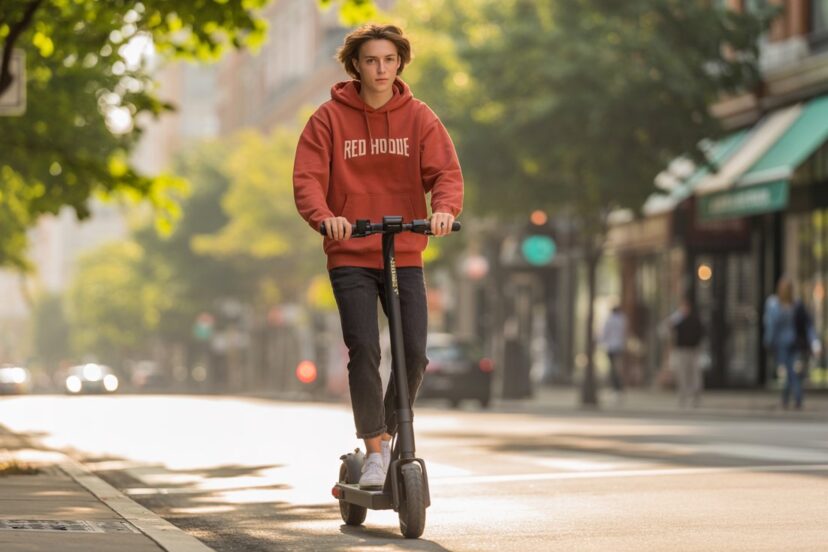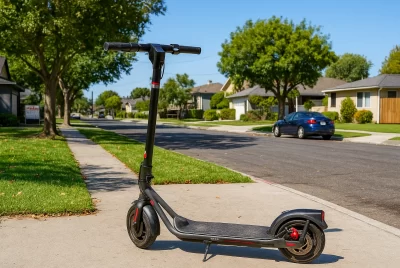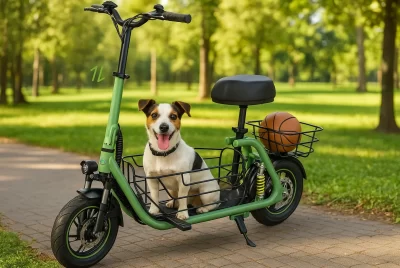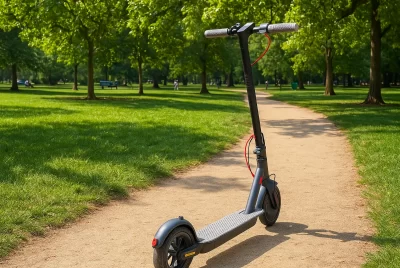What the New Montana E-Scooter Law Means for Riders
*We may earn a commission for purchases made using our links. Please see our disclosure to learn more.
The hum of an electric scooter cutting through the morning silence used to come with an uncomfortable question mark. Was this legal? Would I get pulled over? These concerns became all too familiar for Montana riders navigating the legal gray area that surrounded e-scooters—until now.
Montana has finally caught up with the micromobility revolution. After years of uncertainty, the state legislature has provided the clarity that thousands of current and potential riders have been waiting for. This landmark legislation doesn’t just make e-scooter riding legal; it transforms how we think about short-distance transportation across Big Sky Country.
Having followed micromobility legislation across multiple states, I can confidently say this represents more than regulatory housekeeping. Montana’s approach acknowledges that our transportation landscape is evolving rapidly, and our laws need to keep pace with innovation. For a state known for its vast distances and car-dependent culture, embracing e-scooters signals a progressive shift toward diverse, sustainable mobility options.
“For the first time this year, anyone cruising around the state on an electric scooter will be doing so with the blessing of the Montana Legislature.”
— NBC Montana
Key Takeaways
- Legal Clarity: Montana now provides clear legal framework for e-scooter operation, removing previous uncertainty
- Safety First: The new law emphasizes responsible riding practices and public safety considerations
- Infrastructure Development: Legal recognition may encourage improved infrastructure for e-scooter users
- Economic Benefits: New business opportunities and tourism applications become possible
- Environmental Impact: E-scooters offer sustainable transportation alternative for appropriate trips
- Community Responsibility: Riders must operate safely and considerately to maintain positive public perception
- Seasonal Considerations: Montana’s climate requires adaptive riding strategies throughout the year
- Future Growth: The law provides foundation for continued development of micromobility options
The Journey to Legal Recognition
Montana’s path to e-scooter legalization wasn’t an overnight decision. State gets current with new rules for ‘seatless’ rides previously unauthorized on public roadways. The state had been operating in something of a legal gray area when it came to electric scooters, with riders often uncertain about their rights and responsibilities on public roads.
The transformation came through careful legislative consideration, recognizing that modern transportation needs require modern solutions. Unlike traditional bicycles or motorcycles, electric scooters occupy a unique space in the mobility ecosystem—they’re faster than walking, more portable than bikes, and more accessible than cars for short-distance travel.
What This Means for Your Daily Commute
If you’ve been hesitant to incorporate an e-scooter into your daily routine due to legal uncertainties, those days are behind you. The new law provides the clarity that riders, law enforcement, and municipalities have been seeking. Whether you’re commuting to work in Bozeman, exploring the streets of Missoula, or navigating the broader Montana landscape, you now have legal standing.
The emotional relief that comes with this legal recognition cannot be overstated. There’s something deeply freeing about knowing that your choice of transportation is not only environmentally conscious and economically smart, but also fully supported by state law.
Understanding the New Legal Framework
Key Provisions of Montana’s E-Scooter Law
The new legislation establishes several crucial elements that every rider should understand:
- Definition and Classification: Montana now recognizes electric scooters as a distinct category of vehicle, separate from traditional bicycles or motorcycles. This classification acknowledges the unique characteristics of e-scooters and provides appropriate regulatory framework.
- Operational Requirements: The law establishes specific guidelines for where and how e-scooters can be operated, ensuring both rider safety and public welfare. These requirements balance the need for mobility freedom with responsible use of public spaces.
Personal Safety and Equipment Standards
Beyond legal requirements, the new law establishes important safety benchmarks that protect both riders and the public. These standards address helmet usage recommendations, equipment specifications, and operational guidelines that reflect lessons learned from other states’ experiences with e-scooter integration.
The legislation also considers the unique challenges of Montana’s terrain and weather patterns. Unlike states with consistently mild climates, Montana’s regulations acknowledge that riders need flexibility to adapt to seasonal conditions while maintaining safety standards.
Insurance and Liability Considerations
One aspect that many riders overlook is how legal recognition affects insurance coverage and liability issues. With e-scooters now recognized as legitimate transportation devices, riders should review their insurance policies to understand coverage implications. Some homeowners or renters insurance policies may provide coverage, while others might require additional protection.
The legal clarity also helps establish clearer liability frameworks in case of accidents or property damage. This protection benefits not only riders but also property owners, municipalities, and other road users who interact with e-scooter traffic.
One of the most significant aspects of this new law is how it addresses real-world riding scenarios. Previously, a rider might have wondered whether they could legally use their e-scooter on a particular street or path. Now, there’s a clear framework that removes much of that uncertainty.
The law also provides guidance for law enforcement, which means more consistent application of rules across different municipalities. This consistency is crucial for riders who travel between different cities or counties within Montana.
Overcoming Common Challenges
Budget Considerations and Accessibility
One of the challenges many potential riders face is the initial investment in an e-scooter. While the new law doesn’t directly address cost barriers, it does create a more stable legal environment that could encourage more competitive pricing and rental options throughout the state.
For those considering their first e-scooter purchase, the legal clarity provided by this legislation adds significant value to that investment. You’re not just buying a transportation device; you’re investing in a legally recognized form of mobility.
Storage and Maintenance Realities
Living in Montana means dealing with varying weather conditions and terrain. The new law’s recognition of e-scooters as legitimate transportation devices may encourage more businesses and public spaces to provide appropriate storage facilities. This practical consideration can make the difference between e-scooter ownership being convenient or burdensome.
Integration with Existing Transportation Infrastructure
Montana’s transportation infrastructure was primarily designed for cars and traditional bicycles. The new e-scooter law creates opportunities for communities to consider how these devices fit into existing bike lanes, pedestrian areas, and traffic patterns. This integration process will likely evolve over time as communities gain experience with increased e-scooter usage.
The Broader Impact on Montana’s Transportation Landscape
Environmental Benefits
Montana’s pristine natural environment is one of its greatest assets. E-scooters offer a zero-emission alternative for short trips that might otherwise require a car. With legal backing, more residents may choose e-scooters for quick errands, short commutes, or recreational activities, reducing overall vehicle emissions.
Economic Opportunities
The legal recognition of e-scooters opens doors for new business models in Montana. E-scooter sharing services, repair shops, and specialized retailers now have greater confidence to invest in the Montana market. This could mean more jobs and economic activity, particularly in urban areas.
Economic Impact on Local Communities
The ripple effects of legal e-scooter recognition extend far beyond individual transportation choices. Small Montana communities may see new opportunities emerge as e-scooter accessibility increases foot traffic to local businesses. Tourists spending a few extra hours exploring downtown areas on e-scooters contribute to local economies in ways that quick car-based visits cannot match.
Local entrepreneurs are already recognizing opportunities to provide specialized services—from e-scooter rentals tailored to Montana’s terrain to guided tours that showcase areas best experienced at scooter speed rather than car speed. These business opportunities create jobs and keep tourism dollars circulating within communities.
Public Health Benefits
E-scooters occupy an interesting middle ground between sedentary car travel and intensive bicycle exercise. While not as physically demanding as cycling, e-scooter riding still engages core muscles, improves balance, and encourages outdoor activity. For Montana residents dealing with long commutes or limited transportation options, e-scooters provide a more active alternative to purely passive transportation.
The mental health benefits shouldn’t be overlooked either. The freedom to explore communities at a comfortable pace, combined with the fresh air and mild physical activity, can significantly improve daily well-being. Legal recognition removes the stress and uncertainty that previously accompanied e-scooter use, making these health benefits more accessible.
Integration with Public Transportation
Montana’s public transportation options vary significantly between urban and rural areas. E-scooters can bridge critical gaps in these networks, providing first-mile and last-mile solutions that make public transportation more practical for more people. A commuter might drive to a park-and-ride facility, take public transportation to their destination area, then use an e-scooter for the final portion of their journey.
This integration becomes especially valuable in Montana’s college towns, where students need affordable, flexible transportation options that work across varying distances and schedules. Legal recognition makes these multi-modal transportation strategies more viable and reliable.
Practical Advice for New and Experienced Riders
Getting Started Safely
If you’re new to e-scooter riding, the legal clarity provided by Montana’s new law is just the beginning. Consider starting with shorter trips in familiar areas to build confidence and skills. Practice in low-traffic areas before venturing onto busier streets.
Advanced Riding Techniques for Montana Conditions
Montana’s diverse landscape requires riders to develop skills beyond basic scooter operation. Hills, varying road surfaces, and unpredictable weather demand advanced techniques that many urban-focused guides don’t address. Learning to manage battery life in cold temperatures, adjusting riding style for gravel or uneven surfaces, and understanding how altitude affects performance become crucial skills for Montana riders.
Technology and Smart Riding
Modern e-scooters come equipped with smartphone connectivity, GPS tracking, and advanced battery management systems. The new law’s recognition of e-scooters as legitimate vehicles means these technological features gain additional importance. Riders can now confidently use navigation apps to plan routes, track performance metrics, and even locate charging stations without worrying about the legal status of their journey.
Maintenance in Extreme Conditions
Montana’s temperature extremes—from scorching summer heat to bitter winter cold—place unique demands on e-scooter components. Legal recognition means more riders will rely on their scooters year-round, making proper maintenance critical. Battery care in sub-zero temperatures, protecting electronic components from moisture, and maintaining tire pressure across seasonal temperature swings require specific knowledge and preparation.
Regular cleaning becomes especially important when riding on Montana’s dusty summer roads or salt-treated winter surfaces. The investment in proper maintenance tools and techniques pays dividends in extended scooter life and reliable performance.
Community Responsibility
With legal recognition comes responsibility. As e-scooter riders gain legitimacy on Montana’s roads and paths, it’s crucial to ride responsibly and courteously. Your behavior contributes to public perception and could influence future regulatory decisions.
Different Riding Environments
Urban vs. Rural Considerations
Montana’s diverse landscape means e-scooter riders will encounter varying conditions and local regulations. Urban areas like Billings or Great Falls may have different specific rules compared to smaller rural communities. The statewide law provides the foundation, but local ordinances may add additional requirements.
Seasonal Adaptations
Montana’s distinct seasons present unique challenges and opportunities for e-scooter riders. Summer riding offers ideal conditions, while winter may require different strategies or seasonal storage. The new law’s year-round applicability means riders can adapt their usage patterns to seasonal conditions without worrying about changing legal status.
Weather Preparedness
Successful e-scooter integration into your transportation routine requires weather awareness. Montana’s sudden weather changes mean riders need to be prepared for various conditions and have alternative transportation plans when e-scooter riding becomes unsafe.
Building a Community of Responsible Riders
Connecting with Other Enthusiasts
The legal recognition of e-scooters in Montana creates opportunities for rider communities to form and grow. Local meetups, online forums, and organized rides can help spread safety knowledge and build positive relationships between e-scooter riders and the broader community.
Advocacy and Future Improvements
As the e-scooter community grows in Montana, riders will have opportunities to advocate for improvements to infrastructure and regulations. This might include dedicated e-scooter parking areas, improved path connectivity, or clarifications to existing rules based on real-world experience.
Educational Outreach
Experienced riders can play a crucial role in educating newcomers about safe and legal riding practices. This peer-to-peer education helps ensure that the e-scooter community maintains high standards and positive relationships with other road users.
Looking Toward the Future
Montana’s new e-scooter law represents more than just legal recognition—it’s a acknowledgment that transportation needs are evolving and that state policy must evolve accordingly. This forward-thinking approach positions Montana well for future developments in micromobility and sustainable transportation.
The law also demonstrates that Montana is willing to embrace innovation while maintaining appropriate safety standards. This balance is crucial for successful integration of new transportation technologies into existing infrastructure and communities.
Ongoing Evolution
As with any new law, there will likely be refinements and clarifications as communities gain experience with increased e-scooter usage. Riders should stay informed about potential updates and participate constructively in public discussions about e-scooter policy.
Digital Integration and Smart City Development
As Montana communities embrace e-scooter integration, opportunities arise for smart city technologies that enhance the riding experience. Mobile apps that show real-time traffic conditions, weather alerts, and optimal routing for e-scooter travel become more valuable when supported by clear legal frameworks. Some communities may eventually develop dedicated e-scooter lanes or parking areas, supported by digital infrastructure that guides riders to appropriate locations.
Environmental Monitoring and Data Collection
Legal e-scooter recognition opens possibilities for environmental monitoring and transportation data collection that wasn’t feasible during the legal gray area period. Researchers can now study how e-scooter adoption affects air quality, traffic congestion, and urban planning needs. This data becomes crucial for future infrastructure investments and policy refinements.
Workforce Development
The growing e-scooter industry creates employment opportunities beyond direct riding and rental services. Maintenance technicians, charging station operators, route planners, and safety instructors represent emerging job categories that legal recognition helps legitimize and stabilize. Montana’s technical schools and community colleges may eventually develop specialized training programs to support this growing industry.
These career opportunities are particularly valuable in rural areas where traditional transportation industry jobs may be limited. E-scooter services can provide flexible employment options that complement seasonal work patterns common in tourism and agriculture.
Conclusion
Montana’s new e-scooter law marks a significant milestone for riders throughout the state. It represents recognition that modern transportation challenges require modern solutions, and that sustainable mobility options deserve legal support and protection.
As you consider how this law might impact your own transportation choices, remember that legal recognition is just the beginning. The real success of e-scooter integration in Montana will depend on how responsibly and thoughtfully the riding community embraces these new opportunities.
Whether you’re a longtime e-scooter enthusiast who can finally ride with complete legal confidence, or someone considering their first e-scooter purchase, Montana’s new law opens doors that were previously uncertain. The key is to approach this opportunity with enthusiasm tempered by responsibility, ensuring that e-scooters become a positive addition to Montana’s transportation landscape.
The road ahead—literally and figuratively—is now clearer for e-scooter riders in Montana. The legal framework is in place, the opportunities are expanding, and the community is growing. It’s an exciting time to be part of the micromobility movement in Big Sky Country.
Frequently Asked Questions
1. Do I need a license or registration to operate an e-scooter in Montana?
Based on the new legislation, Montana treats e-scooters similarly to bicycles in many respects. Like e-bikes in the state, e-scooters typically don’t require licenses or registration, but riders should verify specific local requirements in their municipality.
2. Where can I legally ride my e-scooter in Montana?
The new law establishes guidelines for e-scooter operation on public roadways and paths. Generally, e-scooters can be used where bicycles are permitted, but specific restrictions may apply to certain high-traffic areas or highways. Check with local authorities for area-specific rules.
3. Are there age restrictions for e-scooter riders in Montana?
While the statewide law provides the framework, age restrictions and helmet requirements may vary by locality. Many jurisdictions require helmets for younger riders, and some may have minimum age requirements for operation.
4. What are the speed limits for e-scooters under Montana law?
The legislation likely establishes maximum speed limits for e-scooter operation, typically aligned with bicycle regulations. Most e-scooter laws limit speeds to 15-20 mph, but specific limits should be confirmed with current legal text.
5. Can I ride my e-scooter on sidewalks in Montana cities?
Sidewalk riding regulations typically fall under local municipal authority. While the state law provides the general framework, individual cities may prohibit or restrict sidewalk riding. Check with your local government for specific sidewalk usage rules.




